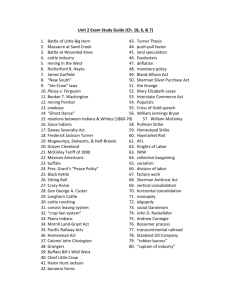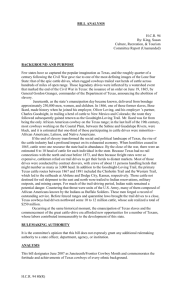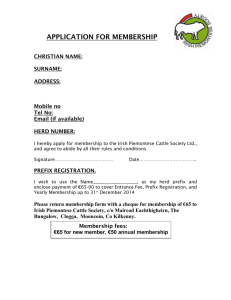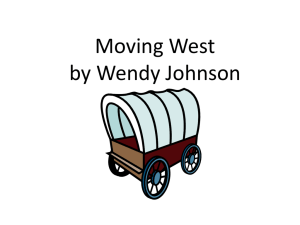Pages 555-570
advertisement
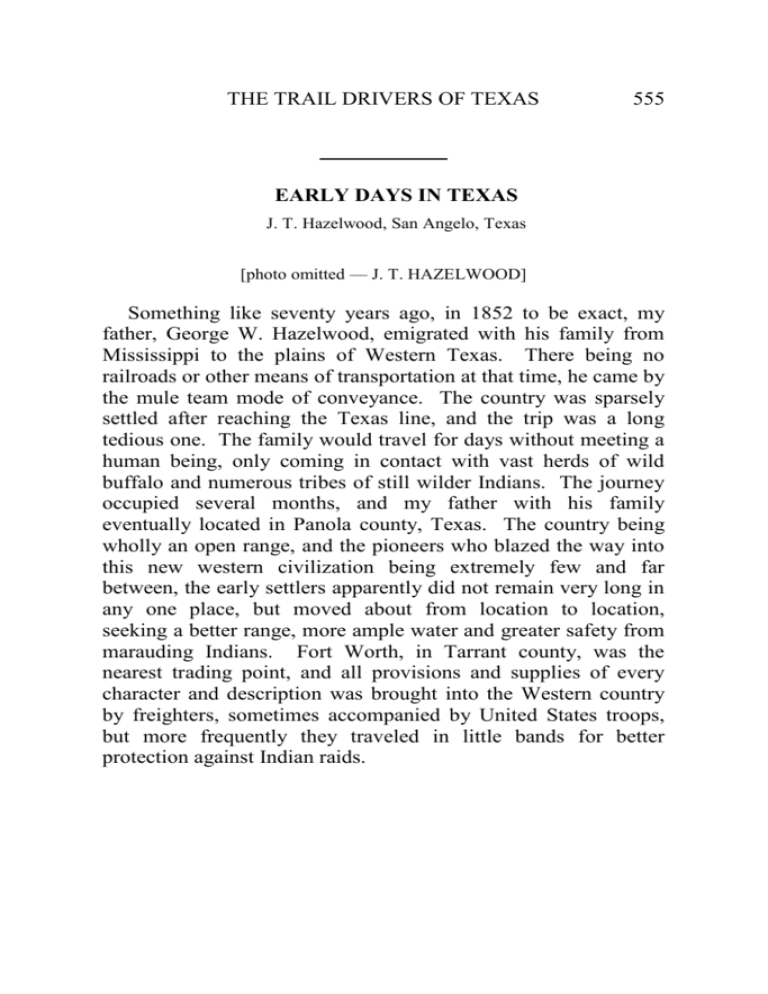
THE TRAIL DRIVERS OF TEXAS 555 EARLY DAYS IN TEXAS J. T. Hazelwood, San Angelo, Texas [photo omitted — J. T. HAZELWOOD] Something like seventy years ago, in 1852 to be exact, my father, George W. Hazelwood, emigrated with his family from Mississippi to the plains of Western Texas. There being no railroads or other means of transportation at that time, he came by the mule team mode of conveyance. The country was sparsely settled after reaching the Texas line, and the trip was a long tedious one. The family would travel for days without meeting a human being, only coming in contact with vast herds of wild buffalo and numerous tribes of still wilder Indians. The journey occupied several months, and my father with his family eventually located in Panola county, Texas. The country being wholly an open range, and the pioneers who blazed the way into this new western civilization being extremely few and far between, the early settlers apparently did not remain very long in any one place, but moved about from location to location, seeking a better range, more ample water and greater safety from marauding Indians. Fort Worth, in Tarrant county, was the nearest trading point, and all provisions and supplies of every character and description was brought into the Western country by freighters, sometimes accompanied by United States troops, but more frequently they traveled in little bands for better protection against Indian raids. 556 THE TRAIL DRIVERS OF TEXAS From Panola county my father moved into Palo Pinto county, settling on Eagle Creek, west of Palo Pinto, at that time a small trading point. Here he went into the ranching business, driving his cattle from one location to another, but due to Indian raids he remained in Palo Pinto county about four years and then was compelled to move to a location of greater security. The Indians, who were very numerous at this period, were making raids over the entire country on all "light nights," stealing horses and mules, driving off cattle and murdering the settlers; the soldiers stationed at the various points in Texas were few in number and insufficient to offer adequate protection to the scattering settlements of white people; and while I was yet quite a small boy during these periods of stress, I can remember very distinctly the conditions and circumstances under which the early settlers were compelled to live and fight for their lives, for the preservation of their herds and for the protection of their families. It was no uncommon thing for the Indians on their raids to steal the entire working outfit of the early settlers, including their horses and mules, and driving away their live stock; in fact, it was almost impossible to keep horses or mules, and it was for that reason the settlers abandoned using them for farming purposes and adopted the ox team instead. It would be impossible to enumerate the number of Indian encounters which took place during the early years of the settling of West Texas between these settlers and these roving tribes. I remember on one occasion when a German by the name of Fred Cola, an employee of my father, was out after cattle on the open range when the Indians made an attack upon him and after running him for several miles finally killed him with an arrow from an Indian bow. It was in 1860 when my father moved with his family to Stephens county, near the line of Shackelford, settling on Sandy Creek, but the Indian depredations continuing, THE TRAIL DRIVERS OF TEXAS 557 he again moved to a safer place, as he thought, over on Battle Creek. The ranges were covered with countless herds of buffalo, deer, antelope, bear and other wild game. We lived in picket houses, covered with sod and dirt, and the flooring with buffalo hides—nothing to compare with the comfortable homes which the people of this country enjoy at the present time, but, nevertheless, the conditions for that day and age were ideal, and we lived in comfort, except that we lived in continual fear of Indian raids. My father killed many deer and dressed their hides, and my mother made clothing of these for the boys and I remember very distinctly the "coon-skin" caps and the "home-made" shoes which were made for the children of our family, and which we were glad to get and took great pride in wearing regardless of the fact that they would not be considered up to date by the present young man about town or the present young society lady preparing for a modern ball. I do not remember very much about fashions in those days, but I am quite sure if I should dress today in the garb which I wore sixty years ago, or if my sisters should dress in the garb which they wore some sixty years ago, and walk down the streets of San Angelo they would cause no little comment and, perhaps, some of the modern up-to-date fashions would be cast into the shade by the old-time apparel worn by the early pioneers. I also remember that we did not regard clothes so much in those days as they are regarded now, and such a thing as ribbons and bows, and lace and silk hose, silk hats and canes for the young men, and a poodle dog with a string around his neck for the young women, would have been considered as much out of place in the early days as, perhaps, our "coon-skin" caps and "homemade" shoes, and our "deerskin britches," our "buffalo coats" and "buffalo shirts" would appear at the present day. Times change, customs change, fashions change, conditions change, but human nature changes but very 558 THE TRAIL DRIVERS OF TEXAS little, and even when I compare the boys and girls of the present day, in the last analysis of their human make-up, with the girls and boys of seventy years ago, I find that they have the same warm hearts, the same happy, cheerful smile, the same creative youthful ambition, and the same desire to succeed, regardless that we are living in a day and age of automobiles, that we are free from Indian depredations and raids, that we no longer see the buffalo roam the plains, and that where the buffalo once roamed and where the Indians perpetrated their raids, beautiful homes and every modern convenience now can be found, and agricultural conditions are changed likewise with modern improvements, yet the heart and mind of the pioneers of the Western range still are found to permeate the posterity of these early pioneers to a very large extent. Having neither railroads nor street car lines, nor electric lines, nor electric lights, nor automobiles, nor auto trucks, nor paved streets, nor hard surfaced roads, nor good bridges across the streams, traveling in those days was indeed very slow, and the method of communication was even slower. As we had no telegraph office, nor telephone office, nor radio stations for wireless communication, the only method of communication and carrying the news was what one neighbor could take to another— and when these neighbors lived some fifty to one hundred miles apart, they did not see each other very frequently and they did not have the opportunity to gossip. The truth of the matter is, as I remember it now, the conditions sixty years ago, while very primitive, were at the same time, from the standpoint of rearing a good and happy family, very substantial, and though we lived far apart, the very fact of this great distance between neighbors only added to the interest which we took in each other, and it was a great pleasure indeed when one family would have the opportunity to spend the night and day with a neighbor fifty or one hundred miles off, and THE TRAIL DRIVERS OF TEXAS 559 it was a greater pleasure for a traveler from some of the more thickly populated settlements to wander through our neighborhood and sit up the entire night and repeat the news to those most interested, in his purely personal way. The latchstring always hung on the outside of the door to everyone but Indians, and a neighbor or a stranger always met with a hearty welcome. We were always glad to see them and sorry to see them go. Our fare may have been homely, and the menu which we set before them might not have consisted of twelve or fifteen courses, but such as it was, it was very wholesome and appetizing, and it was a pleasure to sit around the table in those days. My father did a great deal of trading from Ft. Worth, in the first instance, and afterwards from Weatherford, with ox teams, for the reasons I have heretofore stated—that horses and mules could not be kept on account of Indian raids. In the spring of 1868 my father, with a number of other ranchmen, went out on a roundup, gathering and branding a large number of calves which they had failed to find during the fall roundup. One day they gathered a bunch of these calves and put them in a corral on the Jim Walker ranch, located on Sandy Creek. They always had to camp out because there were no pastures for these roundups. The horses were hobbled at night. The next morning, on this occasion, my father told the men to continue with the branding of the calves, and he would go out and bring in the horses. Finding only a few of them, he returned to camp, then went back to locate the others. During his absence a man coming from another ranch observed a bunch of Indians and he hurried to the camp and gave the alarm, while the men in camp saddled their horses and went to the point where the Indians were last seen. They rode up on a high elevation, looking down into a canyon, where they discovered the Indians, and the Indians at the same time dis- 560 THE TRAIL DRIVERS OF TEXAS covered the men. There being a large party of these Indians and only a few white men, a running fight took place as the men started back to camp, the Indians shooting with bows and arrows, while the men used their guns and pistols. After the Indians had retreated search was made for my father and he was found about a mile and a half from the camp, lying in a branch, where he had been killed by the Indians. He had fought them single-handed for some time, and several pools of blood were found near the battle ground. The Indians were in the canyon preparing to carry off their wounded when the settlers came upon them. After killing my father they did not disturb him except to take his gun, pistol, horse, saddle and bridle. The men went back to the camp, procured a wagon and brought father's body to the ranch the next day. The soldiers came and took the trail of the retreating Indians to the westward, and followed them for several days. The Indians attacked the Ledbetter salt works and then continued their flight westward until overtaken by the cattlemen out near the plains. They were still carrying their wounded, some three or four Indians and a negro. Seeing that they could not retreat further with their wounded they abandoned them in order to make their own escape, and the pursuing settlers coming upon them, killed the wounded themselves. Among these wounded was the Indian who slew my father. A careful examination being made of him, it was found that two of his fingers on the left hand, where he had held the bow, were injured by a bullet wound corresponding to the hole in the bow; the bullet passed on through the bow into the Indian's breast, ranging around his side and coming out at his back. This was conclusive evidence, after the finding of the bow and the blood stains thereon and comparing the wounds found upon the Indian, that he was the same one who slew my father. This bow was afterwards turned over to the government, and is now in the THE TRAIL DRIVERS OF TEXAS 561 museum of the Smithsonian Institute at Washington, D. C. The description of the death of my father on this Indian raid is almost identical in manner and form with hundreds of others who were killed in the early days while West Texas was being settled, and while the account may differ in some few respects, their method was always the same, their character of fighting was always the same, and what has been said of the death of my father would only be a repetition if I should describe the death of a number of other pioneers who were killed during Indian raids, and I am merely giving these facts to show the uncertainties under which the early pioneers lived, the great danger which they constantly faced, and the trials through which they had to pass in order that they might build up the ground work of a greater civilization in this Western country. My father was a pioneer trail driver, and participated in a number of the drives of cattle from the plains of West Texas to the Kansas markets. WORKED FOR GEORGE W. SAUNDERS IN 1875 L. T. Clark, Quanah, Texas In 1869 I hired to Randolph Paine of Denton county to help drive 3,000 four and five year old steers to Abilene, Kansas. We left Denton some time in May and crossed the Red River above Gainsville, crossed the Washita at Fort Arbuckle, crossed the Canadian and Arkansas rivers and went on to the Smoky River. It was a good year and the steers fattened all the way. Paine bought these cattle at $12 per head on time and sold them for $30. He brought the money back to Denton county in a wagon and paid for the steers. Although Mr. Paine was owner and boss of the herd he stood guard at night with the rest of us. 562 THE TRAIL DRIVERS OF TEXAS In 1870 I hired to Hopkins of Denton county to help drive 2,500 big steers to Baxter Springs, Kansas. But Hopkins sold the steers before we reached there, and we came back to Texas. In 1871 Randolph Paine drove 3,200 steers to the end of the M. K. & T. railroad, where a town of tents and shipping pens had sprung up. On this trip we encountered many electrical storms and had several stampedes. [photo omitted — L. T. CLARK] In 1872 Mr. Paine drove three herds to Denison, which was a short drive from Denton county. Mr. Paine died in 1873 and Alec Belcher bought the Paine stock of cattle. I helped to gather and move them to Cook county. In 1874 J. H. Paine, a nephew to Randolph Paine, and I bought 125 saddle horses and drove them to Brown county, where we traded them for 540 grown cattle which we drove to Denison and shipped them to Saint Louis. In 1875 I decided to drift south where they worked cattle the year round. My first stop was south of Goliad, where I hired to George W. Saunders to help gather a herd of cattle he had sold to Dillard Fant of Goliad. When the cattle were counted out to Fant my job was finished. I then went to Atascosa county and hired to Jerry Ellis, who was taking three herds to Dodge City, Kansas. I went up with the last herd of 3,100 head. Moore was boss, and he was a good trail man. When we reached Denton county I went to see my father. J. H. Paine was going to drive a herd of stock cattle to Young county to ranch them, and I made a trade with him to run those cattle four years for one-fourth of the entire THE TRAIL DRIVERS OF TEXAS 563 herd, I to pay all expenses. At the end of the four years Mr. Paine sold the cattle to Ikard of Henrietta, Texas, for $60,000, range delivery. Paine paid me $15,000. I then bought an interest in J. W. Medlin's cattle, range delivery, ranching in Archer county, and in 1885 moved them to Greer county. Then in 1886 I bought an interest in S. F. Reynold's cattle, located in Greer county, and we claimed a range twenty miles wide and thirty miles long, but we did not own any of the land. In 1888 I gathered 1,200 steers and drove them to the Cherokee Strip to pasture. After we crossed the Cimarron River I went on ahead of the herd to secure grazing, and when I reached the next stream it seemed to be bank full and about 400 yards wide, so I decided to swim it. I pulled off my clothes and tied them securely to my saddle and as I started to take the water a man and a woman galloped down on the other side to see me cross. I surmised that I could stand the ordeal if she could, and in I went. The water was not so deep as it seemed to be, and did not swim my horse at all. As I approached the opposite bank where the man and woman were, they turned and galloped away. The woman was from Chicago and her father was one of the stockholders of the Rock Island railroad. They evidently did not like the cut of my "birthday" suit, for they did not remain to see me "come out" in it. In 1890 the settlers moved inside of our range and Medlin and Reynolds thought it best to sell, as the nesters were going to take the country. We sold the cattle to Clark & Plumb of Fort Worth for $9 per head, calves not counted. I drove the cattle to Archer county and turned over 9,030 to them, then sold them the remnant of 300 head on the range. Dayton Moses, now the attorney for the Cattle Raisers' Association, went with the first herd, and made an excellent hand. In 1891 I engaged in buying yearlings for myself, holding them until they were three or four years old and 564 THE TRAIL DRIVERS OF TEXAS shipping to market. I was ranching in the northwest corner of Greer county, and fattened my steers in the Kiowa country, which joined me on the north. I never had any trouble with the Indians. In 1898 a lot of Kansas farmers came into my pasture, so it was my move again. I drove my steers north of Woodward, Oklahoma, fattened them there and put them on the market, sold my claim in Greer county and moved hack to Texas, and have been in the cow business ever since. I now own a ranch in Tom Green county, which is in charge of my son, who is twenty-four years old. We have about 2,000 cattle on the ranch. I have been in partnership with J. H. Paine, J. W. Medlin, and S. F. Reynolds, all first-class gentlemen, and all lived in Denton county. They have all passed away. No better men ever lived. I sold steers to E. H. East for four years. He never put up a forfeit, and we never counted a bunch twice. East lived at that time in Archer City, and owned a ranch in Archer county. He now lives at Kingsville. WAS A FREIGHTER AND TRAIL DRIVER J. M. Cowley, Fentress, Texas My father was born in Tennessee, and he and my mother, whose maiden name was Miss N. G. More, were married in Alabama. They came to Texas in 1853 and located in Milam county, on Little River, where they remained until 1855, then moved to Guadalupe county, where they bought cattle and after a time took them to Caldwell county and located on the San Marcos River. Six children were born to my parents, three of whom are dead. Father bought some mares near the King ranch and drove them to Caldwell county, where he raised horses and mules. The year 1857 was very dry and we had to go to the Brazos River region to buy corn for bread. Cornbread, beef, sorghum molasses and coffee THE TRAIL DRIVERS OF TEXAS 565 was the principal diet in those days, and it was a wholesome diet. [photo omitted — J. M. COWLEY, Fentress, Texas] I was born in Alabama May 29, 1847, and have lived in Texas sixty-nine years. In 1858 Father, Warner Polk and Matthew Clarke began to plan to get their stock back on the home range, as they were pretty badly scattered over the country. T. F. Clark, Frank Polk, W. B. Cowley, my brother, and myself worked together until the Civil War broke out, when Father sent me with Joe Eustace, Fred Houston and Bobbie Dorn to Brownsville with a lot of cotton for Mr. Huff, who lived two miles below the present site of Luling. We brought back dry goods and groceries for him. In 1862 we went below Corpus Christi after salt, and used ox teams to freight with. My team was composed of six yoke of oxen that were pretty hard to manage. In 1865, in company with P. G. Holmes and T. F. Clark, I went to Mississippi with a drove of horses and mules which we had to sell on time, returning home in January, 1867, and the balance of that year I hauled cotton to San Antonio, freighting with mule teams. In the spring of 1869 I went up the trail to Abilene, Kansas, with J. H. Smith, George Eustace, Will Hardeman, S. M. Eeds and Cout Rountree in the outfit. We had 1,500 cattle in the herd, 160 of which belonged to me, 175 belonged to George Eustace, and the remainder belonged to J. H. Smith, who bossed the herd. We went by Waco and Fort Worth, where we purchased supplies to carry us through to Abilene. It was cold and raining most of the time, and creeks an rivers were all 566 THE TRAIL DRIVERS OF TEXAS overflowed. When we came to the Smoky River, Jack Kyle pointing the herd, I was riding a little mule, and when I started in to swim the driver, a man whom we did not know, who was riding a bob-tailed horse, said if my little mule could swim the river "old Bob" could swim it. His horse sank with him and the man was drowned. I threw a rope to him but he failed to catch it. His body was recovered three days later. From Abilene myself and S. M. Eeds shipped our horses and mules to Junction City where we bought wagons, loaded up and started back to Texas, reaching home in November. In 1870, 1871 and 1872 I and my brother, W. B. Conley, freighted to Port Lavaca, and in 1873 we built a home for our parents where Fentress is now located. On November 19, 1874, I was married to Miss Amanda Eastwood, and the following year we moved to the place where my wife was born, two miles above Fentress, where we have lived all these years. We had three children, one of whom died five years ago. The other two, boys, live at Fentress. I served as county commissioner from 1909 until 1916. SOLD CATTLE IN NATCHEZ FOR $4.50 A HEAD A. E. Scheske, Gonzales, Texas I came to Texas with my father and his family in 1855 when I was a small boy. We settled about two miles north of Gonzales, which at that time was a very small place, with just a few stores and a handful of people. The country was all open, mostly prairie, with an abundance of cattle, horses and hogs. And we used to go hog hunting like people hunt deer today, and kill wagonloads of them, some of the finest you ever saw. I believe the cattle business to be the greatest enterprise the world has ever seen, even greater than the manufacture of automobiles is today, considering the time and the conditions. In the early days the cattle THE TRAIL DRIVERS OF TEXAS 567 business was not only the greatest thing to Texans and to the people of the South, but people from everywhere flocked to Kansas to see the vast herds that came from Texas, and the herds that were on the plains there, as well as the buffalo that were so numerous in the early seventies, and which men killed by thousands for their hides from which to make leather and robes. In 1876, when we passed Doan's Store on Red River, we were told that 400,000 cattle had passed there that year for the markets. Lots of them were left unsold and thousands of them froze there that winter. The herd I was with was among those which had to remain through the winter. I do not know of very many of the boys who went up with me that trip. John Henry Lewis, who lives a few miles north of Harwood, a fellow named Van Dyke of Marfa, and my brother, J. A. Scheske, of Terrell, are the only ones that I know of just now, except some negroes. My experiences of the trail dates back to the early sixties, when I was a mere boy. The first trip I ever made was with a bunch of horses for the Confederates under Captain H. S. Parker. We drove to Harrisburg. I made three trips there with horses, two under Parker and one under Captain Kelley. The news of Lee's surrender reached us at Harrisburg, but Captain Kelley went on nevertheless. After the war we drove cattle there in small herds to be shipped. I remember one trip I made with Sam Moore. We had about 400 steers and it was in December, 1868, a very cold winter, Eugene Johnson and I were on herd the first part of the night, a high norther was blowing and it was so cold we couldn't keep our cattle from drifting, and we stayed with them all night. When the boys found us the next morning we could not stand up, our feet and legs were so chilled. In 1869 the first herd went to Kansas and one to Shreveport, La. Bill Greathouse was the first man to leave Gonzales county for Kansas with a herd of cattle. 568 THE TRAIL DRIVERS OF TEXAS He lived about a mile west of the present town of Dilworth, on Peach Creek. They had about 1,000 head. Greathouse himself acted as boss. C. A. Mitchell and Lump Mooney were two that left here with him. In Kansas they all had the cholera and were nursed by the Indians. Mooney and Greathouse died there and Mitchell got well and came back to Gonzales. Andy Moore, who I was with, left Gonzales county for Shreveport, La., in 1869 under the N7 connected brand. We went to Natchez, where the cattle were sold for four dollars and fifty cents a head, steers and stock cattle mixed. In 1870 I left Lavaca county for Sam Moore, who at that time lived at Moulton. A fellow named Burnett of Lavaca county owned an interest in the herd. They turned over to me a thousand head of cattle on the Lavaca Prairie under the Figure 2 brand. Lee Goss, Will Thornton and John Walker (negro) were some of the boys with the herd. We made the trip to Abilene, Kans., in sixty-four days. When we crossed the Red River it was on a rise and we had to make a raft of willow logs. John Walker, and I put the cattle across. We had a fearful electrical storm that night and the other fellows got cut off from us and the negro and myself were left with the herd all night in the Territory. These cattle were sold to a man named True of Missouri, for whom I herded until fall. On this trip, in Kansas, after the cattle had been sold, we lost part of the horses and I went after them, and rode across the plains for three days trailing them by a drag chain. I came across Big Foot Wallace coming from Columbus on his way out to California, and he told me that our horses had taken up with another herd about five miles south of the Little Arkansas. He insisted on me staying all night with him and his crowd. In 1871 I went up the trail for J. H. Paramore, who at that time lived at Gonzales. We had a thousand head of the 3P cattle which we also sold to Mr. True, and we THE TRAIL DRIVERS OF TEXAS 569 crossed the cattle into Iowa where we turned them loose in the cornfields. Those farmers had made lots of corn that year, which was sold for ten cents per bushel where they could sell it. Corn was so plentiful the farmers were using it for fuel instead of wood. We crossed the cattle where St. Louis is today. That place was then about the size of Gonzales today. An election was being held there and Mr. True tried to get the ferry to take our cattle, but the boatman would not do it, said he was too busy getting people across to vote, so we started them across ourselves and the ferryman ran his boat right into the middle of our herd and turned them so we had to clear the way in the usual manner Texans cleared the way in those days. We were in St. Louis when Chicago was burned. In 1872 I started up with a herd of horses for myself, but decided to turn to Louisiana, and we got into the worst money panic the South has ever experienced, and we couldn't sell any of them. We almost starved for lack of food, and when we got down to our last fifty cents we bought a bushel of apples which we lived on for about three days, without anything else. In 1873 I went up with 1,800 head of cattle for Bob Houston and G. W. Littlefield with the Mallet herd. We reached Selina in fifty-five days. The late Ship Parks of the Cross ranch near Fort Stockton, was along, as was also the late D. B. Hodges, J. H. Lewis, a man named Robertson and my brother, J. A. Scheske. That year we passed everything on the road. We made one trip in fifty-four days. A man came to us in Kansas and said that he had heard of us all along the trail and tried to catch us but couldn't. After our herd had been delivered we were started to Fort Sill with 2,200 beeves for the Indians. On our way we had lots of trouble with the Cheyenne tribe. We started with a guide, but he got off with some other herd and the Cheyennes got into our cattle. We had several mix-ups with them, and when the 570 THE TRAIL DRIVERS OF TEXAS old chief got them to milling around he laughed and seemed to be in the height of his glory. After awhile our guide came back to us and advised us to give them two calves and get them stopped, which we did. This guide's name was Porter, and he had a cork leg. I will never forget him, nor how glad I was to see him. He could speak seven Indian dialects. In 1878 I went up the trail with the F— herd for G. W. Littlefield. These cattle were gathered near where Oak Forest is today, and delivered to me on the Lockhart Prairie by W. P. Littlefield, now of New Mexico. We had about 2,000 head. Hess Parks, Jim Cochran, Marcus Dilworth and a fellow named Gay were among those who went with this herd. We delivered on the Platte River in Nebraska. The last trip I made up the trail was in 1882, when I went for the late J. D. Houston of San Antonio, then of Gonzales, and John Rutledge of Yorktown, with the Figure 2 herd. We had 4,500 head and we reached Dodge City, Kansas, in fifty-five days. When we reached the South Canadian it was up and all herds were blocked for seven or eight days. When I rode up the boys asked me if I was going to cross, and after studying the matter over, I decided that I had better cross, so we crossed our cattle and one other herd. We went up the river and the other herd went down it and that night we had another storm and our cattle almost got back into the river, in fact they got into flank water and I told the boys to take their slickers and stampede them. They ran to the Wichita Mountains where we stopped them without losing a steer. The other herd got all mixed up and drifted south that night and we never saw them any more for we went on without any further trouble.



